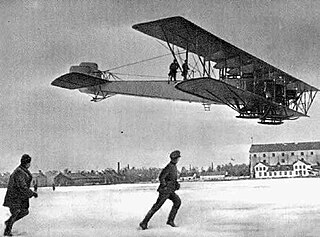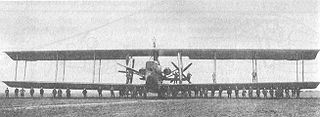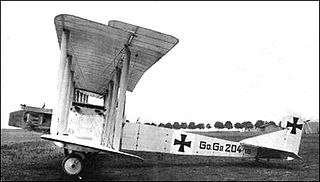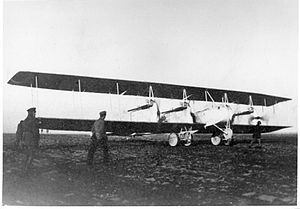
The Fokker D.VII was a German World War I fighter aircraft designed by Reinhold Platz of the Fokker-Flugzeugwerke. Germany produced around 3,300 D.VII aircraft in the second half of 1918. In service with the Luftstreitkräfte, the D.VII quickly proved itself to be a formidable aircraft. The Armistice ending the war specifically required, as the fourth clause of the "Clauses Relating to the Western Front", that Germany was required to surrender all D.VIIs to the Allies. Surviving aircraft saw much service with many countries in the years after World War I.

Heavy bombers are bomber aircraft capable of delivering the largest payload of air-to-ground weaponry and longest range of their era. Archetypal heavy bombers have therefore usually been among the largest and most powerful military aircraft at any point in time. In the second half of the 20th century, heavy bombers were largely superseded by strategic bombers, which were often even larger in size, had much longer ranges and were capable of delivering nuclear bombs.

The Gotha G.V was a heavy bomber used by the Luftstreitkräfte during World War I. Designed for long-range service and built by Gothaer Waggonfabrik AG, the Gotha G.V was used principally as a night bomber.

The Gotha G.I was a bomber aircraft used by the Luftstreitkräfte during the First World War.

The Albatros B.II, was an unarmed two-seat reconnaissance biplane designed and produced by the German aircraft manufacturer Albatros Flugzeugwerke. It was the aircraft that brought Albatros Flugzeugwerke to the world's attention.

The Sikorsky Ilya Muromets was a class of Russian pre-World War I large four-engine commercial airliners and military heavy bombers used during World War I by the Russian Empire. The aircraft series was named after Ilya Muromets, a hero from Slavic mythology. The series was based on the Russky Vityaz or Le Grand, the world's first four-engined aircraft, designed by Igor Sikorsky. The Ilya Muromets aircraft as it appeared in 1913 was a revolutionary design, intended for commercial service with its spacious fuselage incorporating a passenger saloon and washroom on board. The Ilya Muromets was the world's first multi-engine aircraft in production and at least sixty were built. During World War I, it became the first four-engine bomber to equip a dedicated strategic bombing unit. This heavy bomber was unrivaled in the early stages of the war, as the Central Powers had no aircraft capable enough to rival it until much later.

The Zeppelin-Staaken R.VI was a four-engined German biplane strategic bomber of World War I, and the only Riesenflugzeug design built in any quantity.

A Riesenflugzeug, sometimes colloquially referred to in English as an R-plane, was any member of a class of large World War I German bombers, possessing at least three aircraft engines, although usually four or more engines. These large multi-engine aircraft could fly several hours with larger bomb loads than the smaller Grossflugzeug bombers such as the Gotha G.V.

The Albatros G.II,, was a twin-engined German biplane bomber of World War I.

The Gotha G.II series was a heavy bomber used by the Luftstreitkräfte during World War I.

The Gotha G.III was a twin-engine pusher biplane heavy bomber used by the Luftstreitkräfte during World War I. It succeeded the G.II in production and differed primarily in powerplant and in armament details. The G.II's unreliable V-8 Mercedes D.IV was replaced by the new inline six-cylinder 190 kW (250 hp) Mercedes D.IVa engine. The G.III also had a strengthened fuselage with an extra 7.92 mm (0.312 in) machine gun firing through a ventral gun tunnel in the belly to protect the underside of the tail.

The Kennedy Giant was a British biplane heavy bomber designed by Kennedy Aeroplanes Ltd. during the First World War. The design was an imitation of works by Igor Sikorsky, with whom the owner of Kennedy Aeroplanes Ltd., C. J. H. Mackenzie-Kennedy, had ostensibly worked prior to setting up the company. The aeroplane was a notorious failure; its size meant that construction had to take place in an open field as none of the hangars near Hayes, Middlesex, where the prototype was assembled, were large enough to house it. For its weight, the aircraft's four engines were inadequate, and the resulting under-powered aircraft could only fly in a straight line once airborne.
The DFW R.I,, was a prototype German bomber aircraft of World War I.

The Sikorsky S-16, or RBVZ S-XVI, was a Russian equi-span single-bay two-seat biplane designed by Igor Sikorsky in 1914-15. Conceived in response to demand for an escort fighter for the Ilya Muromets bombers, it was noteworthy in that it was one of the first aircraft to possess synchronisation gear for its 7.7 mm machine gun. The first S-XVI was completed on 6 February 1915 with an 80 hp engine instead of the intended 100 hp because of supply problems. On 17 December 1915, the Russian government placed an order for 18 aircraft, these being delivered in early 1916.

The Siemens-Schuckert Forssman was a prototype bomber aircraft designed and built in Germany in 1914 and 1915. When its performance proved inadequate for its intended role, even after numerous modifications, the German Inspectorate of Flying Troops eventually accepted it into service as a trainer. Shortly after its acceptance into military service, the aircraft's fuselage fractured while on the ground, ending its career.

The Zeppelin-Staaken E-4/20 was a revolutionary four-engine all-metal passenger monoplane designed in 1917 by Adolf Rohrbach and completed in 1919 at the Zeppelin-Staaken works outside Berlin, Germany. The E-4/20 was the first four-engine, all-metal stressed skin heavier-than-air airliner built.

The Albatros C.II was a 1910s German military pusher reconnaissance biplane designed and built by Albatros Flugzeugwerke. Only one aircraft was built and the type did not enter production.

The Zeppelin-Staaken Riesenflugzeuge were a series of very large bomber aircraft - Riesenflugzeuge, usually powered by four or more engines, designed and built in Germany from 1915 to 1919.

The Daimler G.I, originally designated Daimler R.I, was a bomber aircraft designed and built in Germany from early in 1915.
The Union G.I was a bomber aircraft designed and built in Germany from 1914.

















